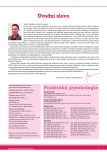-
Medical journals
- Career
Demographic impact of assisted reproduction in the Czech Republic
Authors: J. Kocourková
Authors‘ workplace: Katedra demografie a geodemografie, Přírodovědecká fakulta UK v Praze
Published in: Prakt Gyn 2011; 15(1): 22-27
Category: Review Article
Overview
Objective:
Available data indicate possible demographic potential of the continuously increasing utilization of the IVF/ICSI programme in the Czech Republic. Should ART be supported within policies aiming to increase fertility?Methods:
The interrelationships between fertility indicators and ART data were analyzed. Since the mid 1990s, the Czech Republic has been facing extremely low fertility levels. The ongoing fertility postponement has resulted in an increase in the share of women who decide to reproduce in the older age. Further increase in the number of infertile pairs as well as growing importance of ART for he overall fertility trends in the Czech Republic can, therefore, be expected. There is a continuous increase in the number of children born after ART in the Czech Republic; the number are nearing those for Belgium or Scandinavian countries. However, in the contrary to these countries, the total fertility rate in the Czech Republic has been below the critical level of 1.5 children per woman for more than one decade. There is no uniform opinion from experts on the possible demographic impact of the increased support for ART. Although rather small, the impact is comparable with the impacts of other schemes introduced within social and population policies. Nevertheless, ART appears to contribute to stabilization of the completed fertility rate.Conclusion:
Assisted reproduction is a private matter of individuals. However, the increasing use of ART in the Czech Republic has also had some demographic outcomes. As a result, ART is acquiring a new social meaning within the state population policies.Key words:
fertility – assisted reproduction
Sources
1. Kocourková J. Současný baby boom v České republice a rodinná politika. Demografie 2008; 50(4): 240–249.
2. Goldstein JR. How late can first births be postponed? Some illustrative population-level calculations. Vienna Yearbook of Population Research. Vienna: Austrian Academy of Science 2006 : 153–165.
3. Rychtaříková J. Porodnost. In: Bartoňová D, Burcin B, Fialová L et al (eds). Populační vývoj České republiky 2007. Praha: Přírodovědecká fakulta Univerzity Karlovy v Praze 2008 : 41–50.
4. Lutz W, Skirbekk V, Testa MR. The low-fertility trap hypothesis: forces that may lead to further postponement and fewer births in Europe. Vienna Yearbook of Population Research. Vienna: Austrian Academy of Science 2006 : 167–192.
5. Žáčková T, Mardešič T, Kučera T. Úspěšnost mimotělního oplodnění a demografické aspekty neplodnosti v ČR. Sanquis 2005; 39 : 34–39.
6. Nygren KG, Andersen AN. Assisted reproductive technology in Europe, 1997. Results generated from European registers by ESHRE. Hum Reprod 2001; 16(2): 384–391.
7. Andersen AN, Gianaroli L, Felberbaum R et al. Assisted reproductive technology in Europe, 2001. Results generated from European registers by ESHRE. Hum Reprod 2005; 20(5): 1158–1176.
8. Mouzon J, Goossens V, Bhattacharya S et al. Assisted reproductive technology in Europe, 2006: results generated from European registers by ESHRE. Hum Reprod 2010; 25(8): 1851–1862.
9. Burcin B, Caithamlová E, Kučera T et al. Demografické souvislosti asistované reprodukce v České republice a na Slovensku. Česko-slovenská konference reprodukční gynekologie, Brno 24.–25.11.2004. Prakt Gyn 2004; 8(5): 11–12.
10. Rychtaříková J. Porodnost v České republice: současný stav a nedávné trendy. In: Bartoňová D, Burcin B, Fialová L et al (eds). Populační vývoj České republiky 2001–2006. Praha: Přírodovědecká fakulta Univerzity Karlovy v Praze 2007 : 79–94.
11. Leridon H. Can assisted reproduction technology compensate for the natural decline in fertility with age? A model assessment. Hum Reprod 2004; 19(7): 1549–1554.
12. Grant JC, Hoorens S, Gallo F et al. Should ART be part of a population policy mix? A preliminary assessment of the demographic and economic impact of assisted reproductive technologies. RAND Europe Documented Briefings 2006. Available from: http://www.rand.org/pubs/documented_briefings/2006/RAND_DB507.pdf.
13. Hoorens S, Gallo F, Cave JA et al. Can assisted reproductive technologies help to offset population ageing? An assessment of the demographic and economic impact of ART in Denmark and UK. Hum Reprod 2007; 22(9): 2471–2475.
14. Sobotka T, Hansen MA, Jensen TK et al. The contribution of ART to completed fertility: an analysis of Danish data. Popul Dev Rev 2008; 34(1): 79–101.
15. Habbema JD, Eijkemans MJ, Nargund G et al. The effect of in vitro fertilization on birth rates in western countries. Hum Reprod 2009; 24(6): 1414–1419.
16. Sunde A. Europe’s declining population and the contribution of ART. Pharmaceuticals Policy Law 2007; 9(1–2): 79–90.
17 Kučera T. 2. kuijstenovský seminář aplikované demografie na Albertově: příspěvek do diskuse o roli asistované reprodukce v současném populačním vývoji. Zpravodaj ČDS 2007; 42 : 1–2.
18 Rabušic L. Několik poznámek k české rodinné politice. Demografie 2007; 49(4): 262–272.
Labels
Paediatric gynaecology Gynaecology and obstetrics Reproduction medicine
Article was published inPractical Gynecology

2011 Issue 1-
All articles in this issue
- Cryopreservation of cells and tissues in assisted reproduction
- Demographic impact of assisted reproduction in the Czech Republic
- The methods of skeletal age assessment
- The risks associated with smoking in pregnancy are still underestimated. It is unprofessional and unethical to tolerate smoking in pregnancy
- Correlation between ultrasound, hysteroscopy and histological picture of endometrial polyps
- Mammographic density and the incidence of breast cancer – our experience
- Necrotic myoma in pregnancy
- Pregnancy and delivery by a patient with tension-free vaginal tape – case report and literature review
- Practical Gynecology
- Journal archive
- Current issue
- Online only
- About the journal
Most read in this issue- Necrotic myoma in pregnancy
- The methods of skeletal age assessment
- Cryopreservation of cells and tissues in assisted reproduction
- Correlation between ultrasound, hysteroscopy and histological picture of endometrial polyps
Login#ADS_BOTTOM_SCRIPTS#Forgotten passwordEnter the email address that you registered with. We will send you instructions on how to set a new password.
- Career

